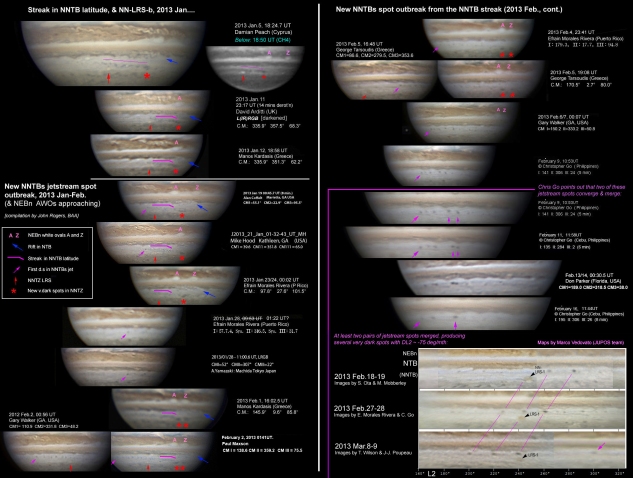
[10) Jupiter update: NNTBs jet; NEBn white ovals; new SED; STB near oval BA.
Since
the previous report (2012/13 no.9) mentioned that several phenomena of interest
were incipient or imminent, and we can now present updates on them with
compilations of images. Many thanks, as always, to all the observers who have
produced many superb images.
1)
NNTBs jet-stream activity resumes (Fig.1):
Since
the NTB upheaval started in 2012 April, the whole N.N.Temp. domain had been
virtually white and the usual NNTBs jet-stream spots had been absent.
On Feb.7, Gary Walker took a fine image on which Manos Kardasis pointed
out: “NNTB dark spots have shown up. Is it a sign that will lead to a NNTB
darkening?”
Indeed,
there was a chain of at least 6 tiny dark spots moving with the NNTBs
jet-stream. The leading spot had DL2
= -89 deg/month, typical of this jet-stream.
The
outbreak arose from the oblique turbulent streak which we noted in the autumn,
in the whitened NNTB latitudes alongside a tiny reddish spot (NN-LRS-b) [see our
Report no.9, esp. Fig.4]. This
streak had transiently appeared as a chain of tiny dark spots, around Dec.1, but
soon faded again. But it persisted, as shown in the images by Alan Coffelt
(Jan.19 & 21) and esp. by Mike Hood (Jan.21).
At that time it had emitted the first tiny dark spot Sp. it in the NNTBs
jet-stream – and also a larger, very dark spot Nf. it in the NNTZ, which was
joined by a second one on Feb.1. So
this turbulent streak in the cyclonic NNTB domain has behaved just like
turbulent cyclonic regions or ‘rifts’ in other domains which generate
prograding spots on one side and slower-moving dark spots in the adjacent zone
on the other side.
By
Feb.4-5, this streak had generated the chain of 6 tiny dark spots in the NNTBs
jet-stream, but had itself become difficult to distinguish.
At
least two pairs of these spots then merged, producing several very dark
jetstream spots with DL2 ~ -75 deg/month (see maps inset in Fig.1).
A few tiny dark spots in the NNTBs latitude are also visible at other longitudes.
2)
NEBn white ovals merging (Figs.1 & 2)
(see
Appendix 2 of our previous report).
Observers were keenly watching the two great white ovals on the NEBn, white spot A and white spot Z, as they approached each other in 2013 Jan., and they interacted closely between Feb.10-19, a dramatic “wrestling match” leading to a partial merger. Unfortunately there were gaps of several days without images during this time. But the event seems to have been similar to previous such encounters. The p. oval (WS-A) squeezed round the S side of the f. one (WS-Z), becoming a white loop. Part of this loop probably merged with WS-Z, but part detached and continued in the f. direction (L2 ~ 16 --> 20), at least up to March 8.
FIGURE 02 & 3 CLICK IMAGE ABOVE FOR FULL SIZE FIGURES.
3)
New S. Equatorial Disturbance (SED) (Figs.3 & 4)
(see
Appendix 4 of our previous report).
There was dynamical evidence of a new SED in autumn, 2012, but only occasional visible signs of such a disturbance, until late Dec., when new feature looked more like a classical SED as it approached the GRS in late Dec. (Fig.S4 in previous report). It passed the GRS on Dec.27, and fulfilled expectations by opening up as a distinct SED soon after. Now it has been followed for its first full circuit of the planet with typical SED appearance, until its next passage past the GRS on Feb.18. Sometimes it showed a white rift into the SEB, later it was more quiescent. However, after passing the GRS again on Feb.18, it did not re-open a rift; instead it became very subdued. So we still cannot be certain whether it will survive or not.
4)
Dark STB segment converging on oval BA (Fig.5)
(see
Figs.11 & 12 of our previous report).
Rapid
changes are occurring because a long-lived STB dark segment, which has been
moving slightly faster than oval BA since 2009, has caught up with it, and is
colliding with the cyclonic structures on the f. edge of BA.
The most obvious of these structures recently has been a very dark brown
cyclonic oval or barge, but it has shrunk to a very small size, and a dull-white
cyclonic oval has also been present just f. it.
Now that the STB dark segment has actually collided with these, a new
bright anticyclonic white oval has appeared, and rapid changes are occurring in
the region. The attached images
identify the main features.
This
type of collision has been observed twice before, once in 2003/04 and once in
2010.
The
2010 event was described at the time (see our reports, 2010/11 no.4 & no.8).
The
2003/04 event was also notable at the time but we did not realise entirely what
was happening until now. As it happens, we are just completing a long-term
survey of the S.Temperate region (to be posted in the next few weeks) and it
shows that these two events were comparable, and about to be repeated right now.
The expected consequences are:
--
Rapid and perhaps spectacular small-scale changes in the region (methane images
may be valuable), until the long dark STB f. BA stabilises;
--Oval
BA suddenly accelerates (indeed it has already done so in early December,
according to the latest JUPOS chart, although that might have been due to its
passage past the GRS);
--A
substantial outbreak of small dark spots prograding on the STBn jetstream p.
oval BA;
--Dark spots or streaks spreading in the opposite direction Sf. the merging STB complex.
FIGURE
05 CLICK IMAGE ABOVE FOR FULL SIZE FIGURE.
John
Rogers,
2013
March 18
John H. Rogers, Ph.D. Jupiter Section Director,
British Astronomical Association
jhr11@cam.ac.uk
http://www.britastro.org/jupiter/